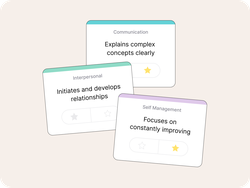
4 coaching strategies for managers from Skills Coach

What makes a good manager? While many factors need to be considered, Google found that being a good coach is one of the most common traits found in top managers.
But coaching isn’t an ability that managers are born with. It’s a collection of skills – from active listening to asking questions – that needs to be put into daily practice. Unfortunately, many organizations expect managers to acquire these skills on their own, which ultimately sets them up for failure. This pain point is what fueled Culture Amp to launch Skills Coach, which was built to help your team better support managers when it comes to developing critical skills – including coaching strategies.
What is Skills Coach?
Skills Coach is a series of personalized programs containing engaging, conversational micro-learning content that was created by our People Scientists in partnership with Lifelabs Learning. While Skills Coach delivers many courses, our focus in this post will be on the Coaching course. So what exactly are the benefits of using Skills Coach?
- Drives behavior change. Skills Coach dives deep into the skills managers need most to succeed in their roles. We use conversational micro-learning to deliver activities directly to managers where they work – in Slack or email. These highly actionable exercises take less than two minutes to complete and help busy managers put their new coaching strategies into practice.
- Accommodates the flow of work. Each Skills Coach program consists of about 20 two-minute exercises, which are delivered daily with nudges via Slack. This allows managers to find pockets of time in their busy schedules to complete the course at their own pace.
- Backed by science. Skills Coach is backed by behavioral science. For example, we use the power of spaced repetition, which is the act of distributing learning over time, to help managers learn more effectively. Spacing has been shown to soften the “forgetting” curve, help learners retain more information, and apply it in new ways.
In the next section, we’ll give you a sneak peek into the types of strategies, recommendations, and action items that the Skills Coach coaching course will teach your managers.
A snapshot: Skills Coach in action

In Skills Coach, managers are taken through bite-sized, highly actionable lessons that arm them with strategies to become better coaches. Below, we highlight four coaching strategies for managers taken directly from Skills Coach, along with the tips and action items we give managers.
1. Avoid “solution mode”
Never underestimate the power of asking questions. Culture Amp surveyed 600 people about their feelings toward their manager, and of the 600 people surveyed, 75% agreed their manager asks questions before giving advice. This is encouraging to see, given that being asked questions allows employees to arrive at their solutions – instead of being told what to do – and can create more investment in outcomes. Asking direct reports questions is also especially important in the context of managing remote team members, where it’s often harder to communicate clearly.
That’s why one of the coaching strategies for managers to adopt is to avoid going into “solution mode” and instead get into the habit of asking questions over giving advice. We share some tips below that managers can use to get started:
Tips
- Wait two seconds before giving a response. Many managers view breaks in conversations as awkward or uncomfortable. As a result, they’ll try to jump in and fill the silence immediately. Instead of doing this, encourage your managers to pause and reflect before responding. This small break can give them time to think and help managers move past any first impulse to jump to a solution.
- Have some questions ready to go. If coming up with questions on the fly is challenging for managers, it may be helpful for them to prepare a few in advance. That way, they’ll always have a few to turn to when they get stuck. Some ideas include: “What are your thoughts so far?”, “What have you already tried?”, and “What are your options?”
Action item
In the next 24 hours, encourage managers to pay attention to when they’re in "solution mode" and when they’re in "coaching mode." This will give them a better sense of how much time they’re spending in each and where there might be an opportunity to improve.
2. Ask open-ended questions
Imagine an employee is in a meeting with their manager, and the conversation goes like this:
“Hope you’re having a good day. Can I ask you a few quick questions about the sales figures? New business this month was what lifted the revenue, right? Due to the low acquisition costs associated with Wingams? Can we agree to do the same again next month for Hoggarts? Great, I think that’s it for now, okay?"
After a conversation like this, an employee will likely be left feeling disconnected. Instead of asking these transactional questions, encourage managers to take advantage of more open-ended questions to leave more room for conversations and input.
Tips
- Choose the right phrasing. Open-ended questions are questions that can’t be answered with a simple "yes" or "no." That’s why it’s important to phrase questions the right way. Open-ended questions tend to start with words like "how," "what," "where," "when," and "who." For example: "What do you think contributed to the revenue lift this month?" or "How do you think we could do this again this next month?"
So, if we were to revisit the last example, the conversation might sound more like this:
"How are you today? I’d like to discuss sales. What do you think is the highest priority? What do you think contributed to the revenue lift this month? What did we learn that we can apply again? How do you think we could do this again this next month?"
Action item
Encourage managers to start their next conversation with an open-ended question – right after the initial greeting. This can be something as simple as, "How are you?” or a slightly more specific query like, "What’s on your mind this week with work?” It’s vital for managers to actively listen to the response so they can engage with additional follow-up questions as needed.
3. Adopt a growth mindset
After working with someone for a while, building expectations around how they’ll act is normal. Unfortunately, this can lead to us thinking of their behavior and ability as set or "fixed." To prevent this from happening between managers and employees, it’s important to encourage a growth mindset, which views people's abilities as something that can be developed and grown.
With this mindset, managers are more likely to encourage their direct reports to view challenges as opportunities, prioritize learning over seeking approval, and focus on the process instead of the result.
Tips
- Ask growth-focused questions. As we saw in the previous section, questions are a powerful way to drive behaviors. That’s why a great way for managers to practice the growth mindset is to ask their employees the right types of questions. For example: “What could you learn from this situation?”, “What might you try differently next time?” or “I can see that you are making progress; what do you think is the next best step for you?”
Action item
Have your managers start team meetings or 1-on-1 conversations with a growth-focused question. That way, they know they’re setting the right tone for the dialogue and are encouraging the same mindset in their employees.
4. Use playbacks
You don’t always need guidance to solve a problem. Sometimes all you need is a nudge to organize your thoughts and feelings. Knowing this, playbacks are an effective way for managers to offer this nudge to their team. Using playbacks comes with four key benefits:
- Focus. Playbacks allow someone to "hear" their thoughts. This can help them focus and clarify their thinking, increasing self-awareness.
- Understanding. Playbacks help clarify misunderstandings. However good your listening skills are, only the speaker can tell you if you have understood correctly.
- Encouragement. Playbacks encourage people to continue talking, reframe what they said, and go deeper into their thoughts, perspectives, and feelings.
- Empathy. Playbacks help you empathize with the listener to understand their thoughts and feelings better.
Whether your managers are already skilled at playbacks or looking to incorporate this practice for the first time, they can use a few tips.
Tips
- Tap into emotions. Managers can add more value to their team by reflecting on feelings and emotions in addition to what’s being said. Reflecting on the impact of what an employee is saying demonstrates that the manager understands how they’re feeling, as well as what they’re saying. This builds empathy and encourages openness.
- Call out the playback. For managers who are newer to using playbacks, the concept can feel strange and out of place. To make it easier, it may be helpful for managers to call out that they will playback what an employee has said. This can be done by saying, “Can I play that back to you, just to make sure I understood you correctly?” The more managers practice this, the easier and more natural it will become.
Action item
Have managers find an opportunity to use a playback. If it's appropriate, also encourage them to insert the feeling they’re hearing, as well as a summary of what was said. This is a great way to make employees feel heard.
Help managers become better coaches with Skills Coach
Coaching is one of the most critical skills a manager needs to succeed in the modern workplace. That's why prioritizing the coaching strategies and skills of managers will increase the performance and engagement of the rest of your organization. We’re thrilled to offer Skills Coach as a way to better support and develop the skills of your managers.

Thinking about introducing Skills Coach to your organization?
Request a demo from the Culture Amp team.


